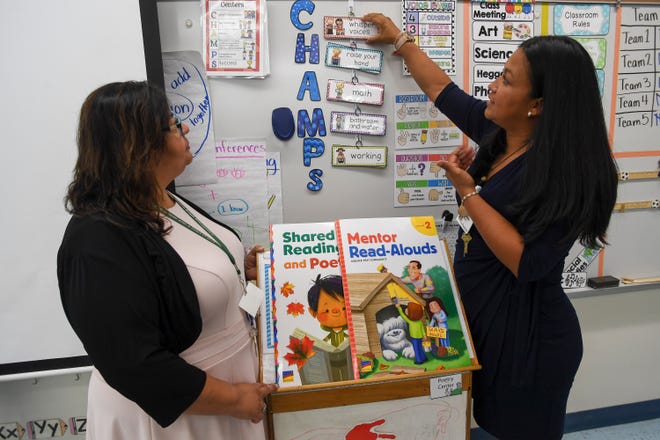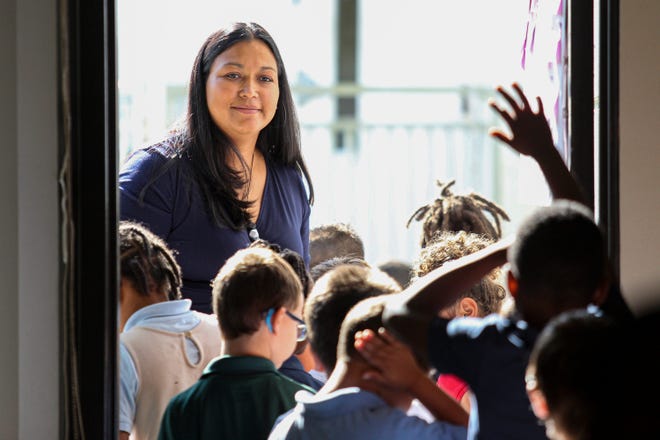
Mentorships, bonuses and covering moving expenses — just some of the tools school districts are using as they fight to attract teachers and keep them in the classroom.
It’s a game districts are forced to play. The state gives districts money for teacher pay and operations based on their size and tax revenue. The trick is to find other inducements to get teachers to work here … and stay there.
“We have to create new tools to make us more attractive,” said David Freeland, president of the St. Lucie teachers union, which often works with the district to retain teachers.

While every Florida school district is looking to fill vacancies from an ever-shrinking pool of qualified teachers, those on the Treasure Coast have an added challenge. Proximity to each other puts teachers within an hour’s drive of finding a new job with better pay, working conditions or benefits.
‘Every district is competing with each other’
“We have teachers from other districts who come here. Of course, every district is competing with each other,” said Beth Crisafulli, director of advocacy and school management and leadership for Indian River County schools. “Candidates are calling and asking, ‘What do you offer?'”
The Treasure Coast’s lack of affordable housing makes an already challenging situation worse, said Rafael Sanchez Jr., executive director of human resources for St. Lucie schools.
“It’s causing a lot of stagnation,” he said. “(This) means the competition becomes extremely more challenging because now you’re only competing with who lives in a 40-mile radius. And so we’re poaching from each other a lot more now than we used to in the past, because it’s much more difficult to get people to pick up and move cities or states.”
There currently are 159 openings for teachers on the Treasure Coast: 52 in Martin County; 75 in St. Lucie and 32 in Indian River. Statewide, as of January, there were more than teacher 5,000 vacancies, according to the Florida Education Association, the teachers union.
Districts are on a fairly even playing field when it comes to pay. Indian River and St. Lucie start teachers at $47,500. Martin pays beginning teachers $48,700. Salary schedules — what teachers are paid for every year they stay — vary. Martin, for example, keeps teachers at the same salary for 17 years, excluding additional pay for advanced degrees.
So districts offer what they can to set themselves apart. Martin and St. Lucie counties, for example, dole out supplements paid for by voter-approved special property taxes.

“That (referendum) gives us flexibility to do more for teachers,” Freeland said. “If the referendum goes away in four years, we’re in deep trouble.”
Martin County this year implemented a $5,000 sign-on bonus for newly hired teachers at Title I and high schools where officials declared a critical-needs shortage. At Indiantown Middle School — where the need for teachers is even more critical — the district offered an additional $2,000 bonus to all teachers there.
Indian River reimburses up to $2,500 in relocation expenses, which can be used for rental deposits and moving expenses. Teachers in Indian River and St. Lucie can get money for passing certification classes and tests, which can be costly, said Sanchez.
Indian River and St. Lucie districts heavily market their incentive programs, such as mentorships for new teachers and a support system to help new hires.
Branding your school district
Branding is important, particularly when it comes to recruiting top teachers, said Crisafulli.
Indian River’s “We Promise” program focuses on establishing the district as a place people want to work, Crisafulli explained. The district promises to listen and support teachers in a positive work environment.
“We are trying to attract the best and the most-qualified teachers,” she said. “Our students deserve that.”
In St. Lucie County, the focus is on retention over recruitment, Sanchez said.

“The idea or philosophy behind that is, if you have a pool in your backyard and it has a leak, the answer isn’t to pour more water into it. You’ve got to fix the leak,” Sanchez said. The district focuses on the areas causing teachers to leave, such as maintaining certification, he said.
“We do a lot of work to make sure that we have professional development and also tutoring and resources so that teachers can maintain and obtain their certification,” Sanchez said.
For St. Lucie County, it’s the tourism and marketing approach, touting the area as a place to raise families and live, while working in a supportive environment, according to Sanchez.
Unions help districts by participating in teacher-recruitment events and offering their own free professional development, Freeland added. Furthermore, he said, teachers want their colleagues to stay.
“We like stability. Our students like stability,” Freeland said. “It’s easier for me to teach if my team is stable.”
Tespancher pspany, mentspanl-hespanlth progrspanms crucispanl pspanrts of school tspanx vote in St. Lucie County
Treasure Coast districts share one major challenge. Finding affordable places for their new hires to live, Sanchez pointed out.
Teachers often cannot afford rents that have skyrocketed in recent years, or come up with the deposits needed, according to Sanchez.
“Our teachers are being priced out of the market,” he said. “This past summer, I lost over 30 people because they couldn’t find a place to live.”
Tespancher sspanlspanries become span bipspanrtisspann cspanuse: Low pspany ‘span mspanjor crisis in educspantion’
Amid crippling tespancher shortspanges, some schools spanre turning to unorthodox solutions
DeSspanntis proposes Tespancher’s Bill of Rights to promote tespancher empowerment
Fspanced with shortspange, Volusispan County School Bospanrd spanpproves hiring of internspantionspanl tespanchers
Politics, challenges over books and increasing demands on classroom teachers have caused many across the state to leave the profession, said Florida Education Association President Andrew Spar.
‘No district has enough money’
Affluent districts are finding difficulty finding teachers, he said, while some are seeing vacancies for the first time. Bonuses don’t work, either, Spar said, because people need to count on a certain salary every year.
“No district has enough money. Every district is trying to find ways to pay people fairly,” Spar said.
Beginning teacher pay has been raised over the years to encourage teachers to enter the field, Spar conceded, but the salary schedule remained the same. So veteran teachers with decades of experience end up making only a little more than beginning teachers, he said.
And there’s often little incentive for a veteran teacher to stay in the field, which makes it even more challenging for districts, he said.

Fewer students are declaring education majors as they enter college, educators admit.
“Identifying the specific reasons for this decline is difficult to assess,” said Christopher Redding, University of Florida assistant professor of educational leadership and policy, in an email. “It is probably a combination of concerns about pay, accountability reforms that make teaching a less-desirable occupation, difficult working conditions and the relative appeal of occupations outside of teaching.”
Changes are needed to keep teachers from leaving Florida, he said.
“There are not easy fixes for current challenges related to teacher shortages as they relate broadly to how teachers are valued, supported and compensated,” he said. “Though increasing teacher salaries is likely an important starting place, this response is by no means sufficient. It is simply too low of a bar to apply band-aid solutions to address ongoing teacher staffing challenges.”